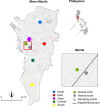Genome-wide detection of Wolbachia in natural Aedes aegypti populations using ddRAD-Seq
- PMID: 38162582
- PMCID: PMC10755911
- DOI: 10.3389/fcimb.2023.1252656
Genome-wide detection of Wolbachia in natural Aedes aegypti populations using ddRAD-Seq
Abstract
Background: Wolbachia, an endosymbiotic bacterium, is globally used to control arboviruses because of its ability to block arboviral replication and manipulate the reproduction of Wolbachia host, Aedes aegypti. Polymerase chain reaction (PCR)-based Wolbachia detection has been recently reported from natural Ae. aegypti populations. However, due to the technical limitations of PCR, such as primer incompatibility, PCR-based assays are not sufficiently reliable or accurate. In this study, we examined double digestion restriction site-associated DNA sequencing (ddRAD-Seq) efficiency and limitations in Wolbachia detection and quantification in field-collected Ae. aegypti natural populations in Metro Manila, the Philippines, compared with PCR-based assays.
Methods: A total of 217 individuals Ae. aegypti were collected from Metropolitan Manila, Philippines. We separated it into 14 populations consisting of 7 female and male populations. We constructed a library for pool ddRAD-Seq per population and also screened for Wolbachia by PCR assays using wsp and 16S rRNA. Wolbachia density per population were measured using RPS17 as the housekeeping gene.
Results: From 146,239,637 sequence reads obtained, 26,299 and 43,778 reads were mapped across the entire Wolbachia genome (with the wAlbA and wAlbB strains, respectively), suggesting that ddRAD-Seq complements PCR assays and supports more reliable Wolbachia detection from a genome-wide perspective. The number of reads mapped to the Wolbachia genome per population positively correlated with the number of Wolbachia-infected individuals per population based on PCR assays and the relative density of Wolbachia in the Ae. aegypti populations based on qPCR, suggesting ddRAD-Seq-based semi-quantification of Wolbachia by ddRAD-Seq. Male Ae. aegypti exhibited more reads mapped to the Wolbachia genome than females, suggesting higher Wolbachia prevalence rates in their case. We detected 150 single nucleotide polymorphism loci across the Wolbachia genome, allowing for more accurate the detection of four strains: wPip, wRi, TRS of Brugia malayi, and wMel.
Conclusions: Taken together, our results demonstrate the feasibility of ddRAD-Seq-based Wolbachia detection from field-collected Ae. aegypti mosquitoes.
Keywords: Aedes aegypti; Philippines; Wolbachia; ddRAD-seq; genome-wide.
Copyright © 2023 Muharromah, Reyes, Kagia and Watanabe.
Conflict of interest statement
The authors declare that the research was conducted in the absence of any commercial or financial relationships that could be construed as a potential conflict of interest.
Figures



Similar articles
-
Detection and quantification of natural Wolbachia in Aedes aegypti in Metropolitan Manila, Philippines using locally designed primers.Front Cell Infect Microbiol. 2024 Mar 18;14:1360438. doi: 10.3389/fcimb.2024.1360438. eCollection 2024. Front Cell Infect Microbiol. 2024. PMID: 38562961 Free PMC article.
-
Fine-scale adaptive divergence and population genetic structure of Aedes aegypti in Metropolitan Manila, Philippines.Parasit Vectors. 2024 May 21;17(1):233. doi: 10.1186/s13071-024-06300-x. Parasit Vectors. 2024. PMID: 38769579 Free PMC article.
-
Detection of Wolbachia in field-collected Aedes aegypti mosquitoes in metropolitan Manila, Philippines.Parasit Vectors. 2019 Jul 24;12(1):361. doi: 10.1186/s13071-019-3629-y. Parasit Vectors. 2019. PMID: 31340862 Free PMC article.
-
Wolbachia infection in field-collected Aedes aegypti in Yunnan Province, southwestern China.Front Cell Infect Microbiol. 2022 Nov 30;12:1082809. doi: 10.3389/fcimb.2022.1082809. eCollection 2022. Front Cell Infect Microbiol. 2022. PMID: 36530420 Free PMC article.
-
Identification and molecular characterization of Wolbachia strains in natural populations of Aedes albopictus in China.Parasit Vectors. 2020 Jan 14;13(1):28. doi: 10.1186/s13071-020-3899-4. Parasit Vectors. 2020. PMID: 31937373 Free PMC article.
Cited by
-
Wolbachia: A bacterial weapon against dengue fever- a narrative review of risk factors for dengue fever outbreaks.New Microbes New Infect. 2025 Mar 8;65:101578. doi: 10.1016/j.nmni.2025.101578. eCollection 2025 Jun. New Microbes New Infect. 2025. PMID: 40176883 Free PMC article. Review.
-
Detection and quantification of natural Wolbachia in Aedes aegypti in Metropolitan Manila, Philippines using locally designed primers.Front Cell Infect Microbiol. 2024 Mar 18;14:1360438. doi: 10.3389/fcimb.2024.1360438. eCollection 2024. Front Cell Infect Microbiol. 2024. PMID: 38562961 Free PMC article.
-
Wolbachia-based emerging strategies for control of vector-transmitted disease.Acta Trop. 2024 Dec;260:107410. doi: 10.1016/j.actatropica.2024.107410. Epub 2024 Sep 28. Acta Trop. 2024. PMID: 39349234 Free PMC article. Review.
-
Revisiting Wolbachia detections: Old and new issues in Aedes aegypti mosquitoes and other insects.Ecol Evol. 2024 Jul 2;14(7):e11670. doi: 10.1002/ece3.11670. eCollection 2024 Jul. Ecol Evol. 2024. PMID: 38957696 Free PMC article.
References
-
- Ahmad N. A., Mancini M. V., Ant T. H., Martinez J., Kamarul G. M. R., Nazni W. A., et al. . (2021). Wolbachia strain wAlbB maintains high density and dengue inhibition following introduction into a field population of Aedes aEgypti . Philos. Trans. R Soc. Lond B Biol. Sci. 376 (1818), 20190809. doi: 10.1098/rstb.2019.0809 - DOI - PMC - PubMed
-
- Andrews S. (2010). FastQC: A quality control tool for high throughput sequence data. Available at: http://www.bioinformatics.babraham.ac.uk/projects/fastqc/.
Publication types
MeSH terms
Substances
LinkOut - more resources
Full Text Sources

